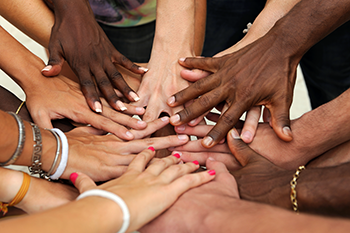
(Posted 2025 October)
 Volunteer Community Partnership Network Provides Space for All Family Services Volunteers
Volunteer Community Partnership Network Provides Space for All Family Services Volunteers
The Department of Family Services Volunteer and Community Partnership Network, or VCPN, is in its tenth year of existence. The network brings together all DFS division volunteer coordinators to better manage the disparate volunteer programs in the agency, as well as provide support for each other. Recently Volunteer Voices sat down with Nadia Hoonan, Volunteer Solutions partnership coordinator and VCPN co-chair, to talk about how the network operates. This is an excerpt from that conversation.
Volunteer Voices: What does VCPN do? What’s its mission?
Nadia Hoonan: VCPN is the Department of Family Services’ volunteer and community partnership network. Our objective is to share ideas, promote and support initiatives, and educate.
Essentially, it’s comprised of volunteer coordinating staff in all of Family Services. It includes me and Emily Swenson from Adult & Aging; Caroline Croghan from Domestic and Sexual Violence Services; Francesca Lovitt and Tiffany Pegues from Children, Youth, and Families; and the VITA staff from PAES. The whole purpose is to have these meetings to talk about what we’re working on. Right now we’re focused on the Universal Impact Report—which comprises information from all the DFS volunteer programs. We’re also focusing on Adopt-a-Family and Adult & Aging’s donation event in the fall. We look at the systems each volunteer program uses, keep a list of staff we can reach out to for support, and get on the same level of reporting information we report out. It’s a good space for all the volunteer programs to come together and talk about what’s going on in each division. It’s an internal group. Conversations started in 2014 to formalize VCPN. And by mid-2015, VCPN was established. It’s nice to start seeing an increase in volunteerism advocacy in DFS.
How do VCPN and DSVS work together?
Our work depends on what the divisions need. We try to stay flexible, so if Caroline needs something specific to our Volunteer Management System or help with a volunteer appreciate event, we all pitch in and provide advice and support. I guide people on where to find resources.
We sometimes partner on events. For instance, for MLK Day, Volunteer Fairfax has a big family day for volunteering. This year we worked on projects for Volunteer Fairfax’s Give Together initiative. Volunteers from all the divisions, including DSVS, came and helped.
We provide mental health services for volunteers. We partner with Myriam Goldin, who leads the self-care sessions for DFS staff to provide self-care sessions for volunteers twice a year. It’s a good opportunity for volunteers to talk confidentially about their experiences, to work through secondary trauma, and manage compassion fatigue. And that’s just one of those trainings we offer.
What’s the best thing about this collaboration?
It brings us together because we are working toward a similar goal of volunteer management. The divisions’ missions vary, and our volunteer style can look very different, so when we come together and talk about the programs, it’s a good way to get ideas about how we work. It’s special with DSVS, in particular, because they have such a training intensive onboarding for their volunteers. That gives me ideas for how we can train other volunteers. Often we find our volunteers double or triple dip into other divisions. When Volunteer Appreciation Month comes around in April, and we want to nominate a volunteer, we can check in with the other divisions they work with so we can provide a well-rounded approach to recognizing that volunteer.
Any challenges?
Some volunteer programs have specific requirements they have to meet—such as specific trainings. Sometimes it’s challenging to figure out a way to make an approach to volunteer management apply within your own program because they’re so different.
I’ve been thinking about ways we show volunteer impact. Currently we use the hourly rate for volunteers and state the value in it. But we’re trying to figure out how we can show the true impact of our volunteers. It’s not only hourly rate, but also the service cost and the additional resources. For example, DSVS’ Hospital Accompaniment Support Advocate volunteers driving to the hospital, so accounting for mileage, or if they speak a specific language. For Adult & Aging we provide medical transportation and transportation to the grocery store. The impact volunteers are actually providing would be so much more if we took those things into account, but it’s really complicated to try to capture that. Each division would have to find a reliable source for an appropriate rate. Even though volunteers provide a significant impact, that number would be higher if we could figure out a way to tie in the service rate as well as the value of the hourly rate. It’s doable but it’s complicated. That’s something that’s been on my mind lately.
Anything our audience might want to know we didn’t talk about?
VCPN offers a lot of benefits to volunteers, such as that self-care training I mentioned, and trainings outside of division-specific ones. One of the recent ones we shared was the QPR Suicide Training. We try to encourage all DFS volunteers to take that. VCPN continues to try to figure out ways we can all come together and provide good quality of service to all the volunteers in the agency and give them opportunities to enhance their skills outside their main roles. Self-care sessions are particularly important for DSVS volunteers. As much as they can decompress with after hours staff, being able to talk about the tricky things of volunteerism—it’s altruistic; you want to give back to your community—but there are challenges. And being able to talk about those challenges with your fellow volunteers is priceless. And it’s a good way to network in the community and come together with people with a like mentality, especially under the DFS umbrella.

